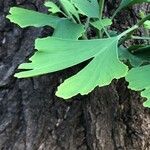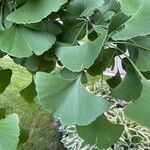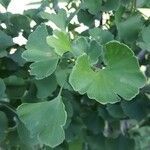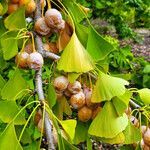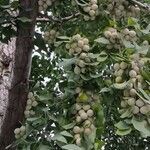Trees to 30 m. Crown somewhat ovoid to obovoid, tending to be asymmetric, primary branches ascending at ca. 45° from trunk. Long shoots faintly striate; spurs thick, knoblike or to 3 cm, gray, covered with bud-scale scars. Buds brown, globose, scales imbricate, margins scarious. Leaves fan-shaped, glabrous except for tuft of hairs in axils, blades 2--9.5 × 2--12 cm, mostly 1.5 times wider than long, apices cleft to truncate; venation dichotomous, appearing parallel; leaf scars semicircular; petioles channeled on adaxial surface, 2.5--8.5 cm. Seeds obovoid to ellipsoid, yellow to orange, 2.3--2.7 × 1.9--2.3 cm, mostly 1.1--1.2 times longer than broad, glaucous, rugose, with apical scar, maturing in single season, usually 1 per peduncle, occasionally polyembryonic, outer coat foul-smelling; peduncles orange, glaucous, ridged, 3--9.5 cm, collar broadly elliptic, 7.2--8.6 mm broad. 2 n = 24.
A large tree. It loses its leaves during the year. It grows to 24-35 m high. They are tall and upright when young and become spreading later. It can be 9 m wide. There are many branches. The small branches are of two forms-long and short. The leaves are arranged in spirals on the long branches. The green leaves are 10 cm long. They are fan shaped. They turn golden yellow in autumn. Trees are separately male and female. The reproductive structures are in clusters in the axils of the scale like leaves at the tips of the short branches. The pollen cones hang down. The ovules are on long divided fruiting stalks. Only one seed ripens on each fruiting stalk. The seeds are long and hang down on stalks. The seeds are edible and nutritious. The fruit have an unpleasant smell.
